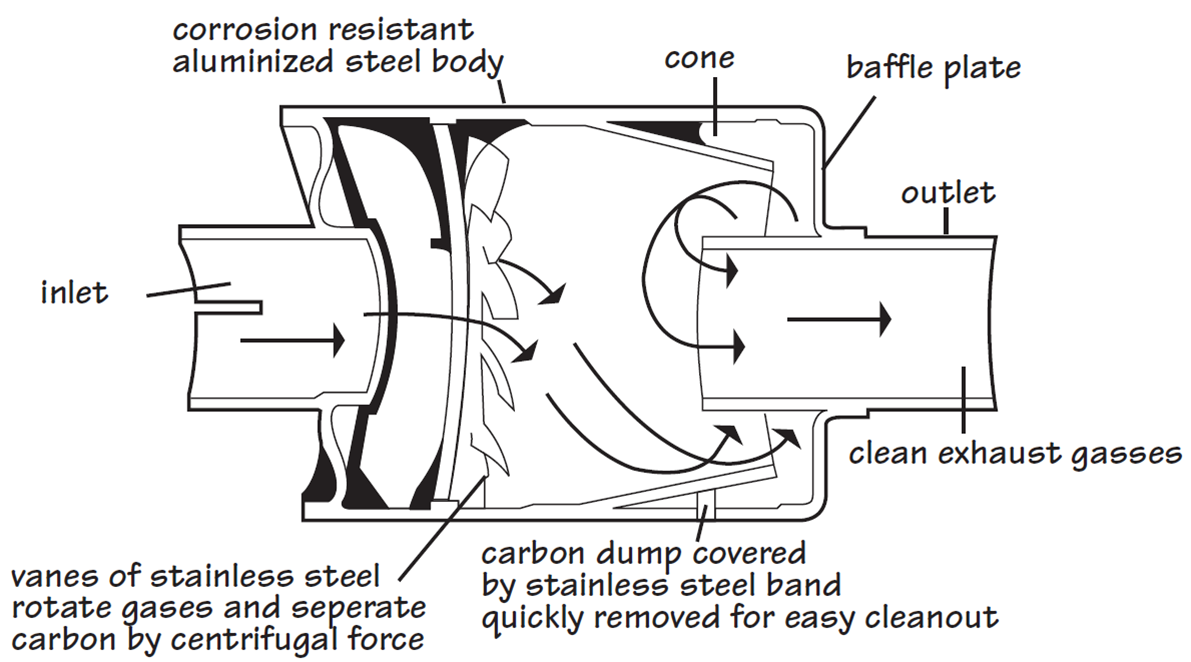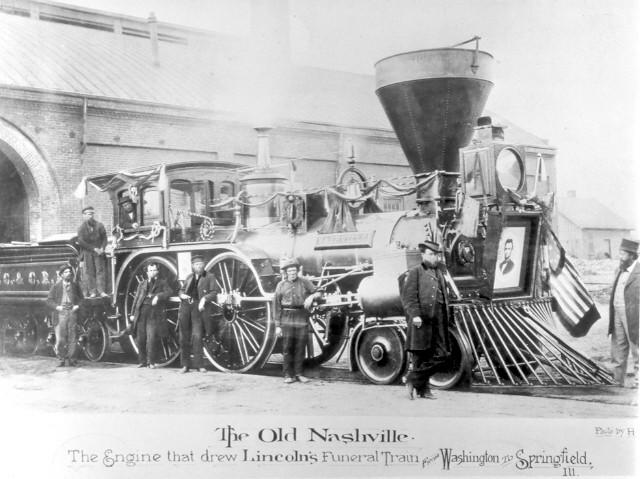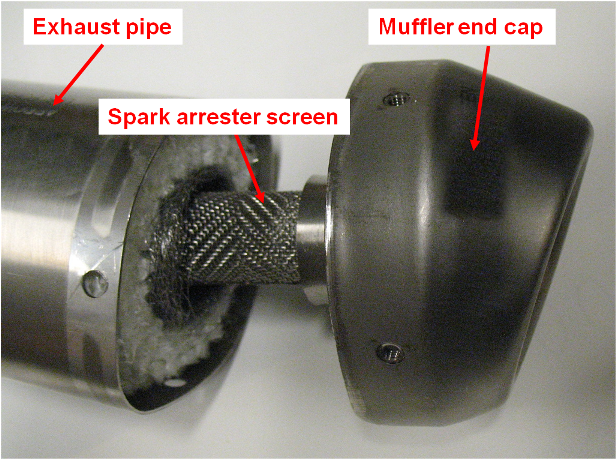Spark Arrestor on:
[Wikipedia]
[Google]
[Amazon]
 A spark arrester (sometimes spark arrestor) is any device which prevents the emission of flammable debris from
A spark arrester (sometimes spark arrestor) is any device which prevents the emission of flammable debris from

 Spark arresters for steam locomotives may be internal (in the form of wire mesh inside the
Spark arresters for steam locomotives may be internal (in the form of wire mesh inside the

 Laws governing spark arrester use in the United States depend on the jurisdiction. Internal combustion engines operating on USDA Forest Service and most other federally managed lands must meet the requirements of the Code of Federal Regulations 36 CFR 261.52. This mandate requires the operator to have a certified and properly maintained spark arrester installed at all times. Many state and local land management agencies defer to the federal requirement.
Laws governing spark arrester use in the United States depend on the jurisdiction. Internal combustion engines operating on USDA Forest Service and most other federally managed lands must meet the requirements of the Code of Federal Regulations 36 CFR 261.52. This mandate requires the operator to have a certified and properly maintained spark arrester installed at all times. Many state and local land management agencies defer to the federal requirement.
 Exemptions exist for automobiles legally registered with their state's department of motor vehicles. During periods of extreme fire danger, land managers may prevent the use of all motorized equipment, even if a properly functioning spark arrester is installed. Spark arrester inspections are performed by trained agency law enforcement or fire prevention personnel. They may occur on an individual basis, or as part of an inspection checkpoint during busy recreation weekends. Operators caught using unqualified or modified devices could be cited. Penalties for violating spark arrester laws depend on the issuing agency. If it is determined a noncompliant vehicle was responsible for starting a fire, the operator could be held liable in civil or even criminal court.
Certification testing of spark arresters is performed by the USDA Forest Service Technology and Development Center in San Dimas, CA. The technical requirements are outlined in Forest Service Specification FS5100-1. All spark arresters meeting the requirements of 36 CFR 261.52 must be certified and listed in the USDA Forest Service Spark Arrester Guide. This guide is a comprehensive directory of all qualified products available in the United States, and is published biannually. The Spark Arrester Guide is used by field inspectors and consumers to verify product certification status. Manufacturers pursuing spark arrester qualification in the United States should consult the USDA Forest Service's "Manufacturer's Submission Procedure" for both general purpose and small engineUSDA Forest Service Technology & Development Program ''Manufacturer Submission Procedure for the Qualification of Multiposition Small Engine Spark Arrester Exhaust Systems'' (200
Exemptions exist for automobiles legally registered with their state's department of motor vehicles. During periods of extreme fire danger, land managers may prevent the use of all motorized equipment, even if a properly functioning spark arrester is installed. Spark arrester inspections are performed by trained agency law enforcement or fire prevention personnel. They may occur on an individual basis, or as part of an inspection checkpoint during busy recreation weekends. Operators caught using unqualified or modified devices could be cited. Penalties for violating spark arrester laws depend on the issuing agency. If it is determined a noncompliant vehicle was responsible for starting a fire, the operator could be held liable in civil or even criminal court.
Certification testing of spark arresters is performed by the USDA Forest Service Technology and Development Center in San Dimas, CA. The technical requirements are outlined in Forest Service Specification FS5100-1. All spark arresters meeting the requirements of 36 CFR 261.52 must be certified and listed in the USDA Forest Service Spark Arrester Guide. This guide is a comprehensive directory of all qualified products available in the United States, and is published biannually. The Spark Arrester Guide is used by field inspectors and consumers to verify product certification status. Manufacturers pursuing spark arrester qualification in the United States should consult the USDA Forest Service's "Manufacturer's Submission Procedure" for both general purpose and small engineUSDA Forest Service Technology & Development Program ''Manufacturer Submission Procedure for the Qualification of Multiposition Small Engine Spark Arrester Exhaust Systems'' (200
/ref> spark arresters.
Off-Highway Vehicle Spark Arresters Tech Tip (USDA Forest Service)
* ttp://www.parks.ca.gov/?page_id=23039 Spark Arrester Law - State of California {{DEFAULTSORT:Spark Arrester Passive fire protection
 A spark arrester (sometimes spark arrestor) is any device which prevents the emission of flammable debris from
A spark arrester (sometimes spark arrestor) is any device which prevents the emission of flammable debris from combustion
Combustion, or burning, is a high-temperature exothermic redox chemical reaction between a fuel (the reductant) and an oxidant, usually atmospheric oxygen, that produces oxidized, often gaseous products, in a mixture termed as smoke. Combus ...
sources, such as internal combustion engine
An internal combustion engine (ICE or IC engine) is a heat engine in which the combustion of a fuel occurs with an oxidizer (usually air) in a combustion chamber that is an integral part of the working fluid flow circuit. In an internal c ...
s, fireplace
A fireplace or hearth is a structure made of brick, stone or metal designed to contain a fire. Fireplaces are used for the relaxing ambiance they create and for heating a room. Modern fireplaces vary in heat efficiency, depending on the design ...
s, and wood burning stoves.
Spark arresters play a critical role in the prevention of wildland fire and ignition of explosive atmospheres. Consequently, their use is required by law in many jurisdictions worldwide.
Applications
Engines
Steam
 Spark arresters for steam locomotives may be internal (in the form of wire mesh inside the
Spark arresters for steam locomotives may be internal (in the form of wire mesh inside the smokebox
A smokebox is one of the major basic parts of a steam locomotive exhaust system. Smoke and hot gases pass from the firebox through tubes where they pass heat to the surrounding water in the boiler. The smoke then enters the smokebox, and is e ...
) or external. The earliest platforms for spark arresters in the United States
The United States of America (U.S.A. or USA), commonly known as the United States (U.S. or US) or America, is a country primarily located in North America. It consists of 50 states, a federal district, five major unincorporated territori ...
were steam locomotives. Wood- and coal-burning locomotives produce embers which are readily transported by the wind. One popular design was the Radley-Hunter spark arrester, which used a spiral-shaped cone to separate embers from the exhaust flow by centrifugal force.
The problem of equipment-started fires continued into the 20th century. University of California, Berkeley
The University of California, Berkeley (UC Berkeley, Berkeley, Cal, or California) is a public land-grant research university in Berkeley, California. Established in 1868 as the University of California, it is the state's first land-grant u ...
researchers J.P. Fairbank and Roy Bainer provided the first known academic research on the subject. Their experiments demonstrated that hot particulate matter larger than 0.023 inches (0.584 mm) in diameter was capable of igniting wildland fuels.
Internal combustion
In the 1950s, theUnited States Forest Service
The United States Forest Service (USFS) is an agency of the U.S. Department of Agriculture that administers the nation's 154 national forests and 20 national grasslands. The Forest Service manages of land. Major divisions of the agency in ...
became interested in reducing the number of fires started by logging equipment in the National Forest System
In the United States, national forest is a classification of protected and managed federal lands. National forests are largely forest and woodland areas owned collectively by the American people through the federal government, and managed by t ...
. This interest led to a partnership with the Society of Automotive Engineers
SAE International, formerly named the Society of Automotive Engineers, is a United States-based, globally active professional association and standards developing organization for engineering professionals in various industries. SAE Internatio ...
and the development of the following test standards for spark arresters:
* SAE J335 – Multiposition Small Engine Exhaust System Fire Ignition Suppression
* SAE J342 – Spark Arrester Test Procedure for Large Size Engines
* SAE J350 – Spark Arrester Test Procedure for Medium Size Engines
Modern technologies have largely eliminated the production of large particulate matter from internal combustion engines. However, as engines wear, carbon
Carbon () is a chemical element with the symbol C and atomic number 6. It is nonmetallic and tetravalent—its atom making four electrons available to form covalent chemical bonds. It belongs to group 14 of the periodic table. Carbon mak ...
deposits can build up on the internal walls of the engine. When these deposits break free, they exit through the exhaust system and present a potential fire hazard. Vehicles without properly functioning spark arresters have been suspected of starting numerous wildfires, including the devastating track fire near Raton, New Mexico
)
, population_demonym = New Mexican ( es, Neomexicano, Neomejicano, Nuevo Mexicano)
, seat = Santa Fe
, LargestCity = Albuquerque
, LargestMetro = Tiguex
, OfficialLang = None
, Languages = English, Spanish ( New Mexican), Navajo, Ke ...
in June 2011.
Today, spark arresters can be found as OEM
An original equipment manufacturer (OEM) is generally perceived as a company that produces non-aftermarket parts and equipment that may be marketed by another manufacturer. It is a common industry term recognized and used by many professional or ...
or aftermarket components on many types of equipment, such as large agricultural machines, off highway vehicles (OHVs), and small engines ( chainsaws, string trimmers
A string trimmer, also known by the portmanteau strimmer and the trademarks Weedwacker, Weed eater and Whipper Snipper. is a garden tool for cutting grass, small weeds, and groundcover. It uses a whirling monofilament line instead of a blade, ...
, leaf blowers, etc.).
Buildings
Spark arresters are also fitted to the top of aflue
A flue is a duct, pipe, or opening in a chimney for conveying exhaust gases from a fireplace, furnace, water heater, boiler, or generator to the outdoors. Historically the term flue meant the chimney itself. In the United States, they are ...
(or a chimney pot) to prevent floating embers from a fire (particularly one burning wood) setting light to a flammable roofing surface (shingle, thatch, or bitumen-felt) or falling onto combustible material on the ground. Such a spark arrester typically consists of a double layer of metal mesh
A mesh is a barrier made of connected strands of metal, fiber, or other flexible or ductile materials. A mesh is similar to a web or a net in that it has many attached or woven strands.
Types
* A plastic mesh may be extruded, oriented, exp ...
, which catches the ember and allows the flue gas to escape.
Large power station
A power station, also referred to as a power plant and sometimes generating station or generating plant, is an industrial facility for the generation of electric power. Power stations are generally connected to an electrical grid.
Many ...
boiler
A boiler is a closed vessel in which fluid (generally water) is heated. The fluid does not necessarily boil. The heated or vaporized fluid exits the boiler for use in various processes or heating applications, including water heating, centr ...
s are commonly fitted with electrostatic precipitator
An electrostatic precipitator (ESP) is a filterless device that removes fine particles, like dust and smoke, from a flowing gas using the force of an induced electrostatic charge minimally impeding the flow of gases through the unit.
In con ...
s.
Electrical equipment
Types
Centrifugal
Centrifugal type spark arresters employ stationary vanes, baffles, or other devices to trap large particles bycentrifugal force
In Newtonian mechanics, the centrifugal force is an inertial force (also called a "fictitious" or "pseudo" force) that appears to act on all objects when viewed in a rotating frame of reference. It is directed away from an axis which is parall ...
. These spark arresters are typically found on heavy agricultural and construction equipment (tractor
A tractor is an engineering vehicle specifically designed to deliver a high tractive effort (or torque) at slow speeds, for the purposes of hauling a trailer or machinery such as that used in agriculture, mining or construction. Most commo ...
s, combines, bulldozers, etc.), but some have been developed for motorcycle
A motorcycle (motorbike, bike, or trike (if three-wheeled)) is a two or three-wheeled motor vehicle steered by a handlebar. Motorcycle design varies greatly to suit a range of different purposes: long-distance travel, commuting, cruising ...
s and other all-terrain vehicles.

Screen
Screen type spark arresters use a physicalmesh
A mesh is a barrier made of connected strands of metal, fiber, or other flexible or ductile materials. A mesh is similar to a web or a net in that it has many attached or woven strands.
Types
* A plastic mesh may be extruded, oriented, exp ...
to prevent large particles from leaving the exhaust system. This is the simplest and most common type of spark arrester. Screen type devices are used on most motorcycles, ATVs, and small engines.
Electrostatic precipitator
Regulatory requirements
United States
 Exemptions exist for automobiles legally registered with their state's department of motor vehicles. During periods of extreme fire danger, land managers may prevent the use of all motorized equipment, even if a properly functioning spark arrester is installed. Spark arrester inspections are performed by trained agency law enforcement or fire prevention personnel. They may occur on an individual basis, or as part of an inspection checkpoint during busy recreation weekends. Operators caught using unqualified or modified devices could be cited. Penalties for violating spark arrester laws depend on the issuing agency. If it is determined a noncompliant vehicle was responsible for starting a fire, the operator could be held liable in civil or even criminal court.
Certification testing of spark arresters is performed by the USDA Forest Service Technology and Development Center in San Dimas, CA. The technical requirements are outlined in Forest Service Specification FS5100-1. All spark arresters meeting the requirements of 36 CFR 261.52 must be certified and listed in the USDA Forest Service Spark Arrester Guide. This guide is a comprehensive directory of all qualified products available in the United States, and is published biannually. The Spark Arrester Guide is used by field inspectors and consumers to verify product certification status. Manufacturers pursuing spark arrester qualification in the United States should consult the USDA Forest Service's "Manufacturer's Submission Procedure" for both general purpose and small engineUSDA Forest Service Technology & Development Program ''Manufacturer Submission Procedure for the Qualification of Multiposition Small Engine Spark Arrester Exhaust Systems'' (200
Exemptions exist for automobiles legally registered with their state's department of motor vehicles. During periods of extreme fire danger, land managers may prevent the use of all motorized equipment, even if a properly functioning spark arrester is installed. Spark arrester inspections are performed by trained agency law enforcement or fire prevention personnel. They may occur on an individual basis, or as part of an inspection checkpoint during busy recreation weekends. Operators caught using unqualified or modified devices could be cited. Penalties for violating spark arrester laws depend on the issuing agency. If it is determined a noncompliant vehicle was responsible for starting a fire, the operator could be held liable in civil or even criminal court.
Certification testing of spark arresters is performed by the USDA Forest Service Technology and Development Center in San Dimas, CA. The technical requirements are outlined in Forest Service Specification FS5100-1. All spark arresters meeting the requirements of 36 CFR 261.52 must be certified and listed in the USDA Forest Service Spark Arrester Guide. This guide is a comprehensive directory of all qualified products available in the United States, and is published biannually. The Spark Arrester Guide is used by field inspectors and consumers to verify product certification status. Manufacturers pursuing spark arrester qualification in the United States should consult the USDA Forest Service's "Manufacturer's Submission Procedure" for both general purpose and small engineUSDA Forest Service Technology & Development Program ''Manufacturer Submission Procedure for the Qualification of Multiposition Small Engine Spark Arrester Exhaust Systems'' (200/ref> spark arresters.
See also
*Flame arrester
A flame arrester (also spelled arrestor), deflagration arrester,
or flame trap
are safety devices fitted to openings of enclosures or to pipe work, and are intended to allow flow but prevent flame transmission fuel combustion by extinguishing the ...
Notes
External links
Off-Highway Vehicle Spark Arresters Tech Tip (USDA Forest Service)
* ttp://www.parks.ca.gov/?page_id=23039 Spark Arrester Law - State of California {{DEFAULTSORT:Spark Arrester Passive fire protection